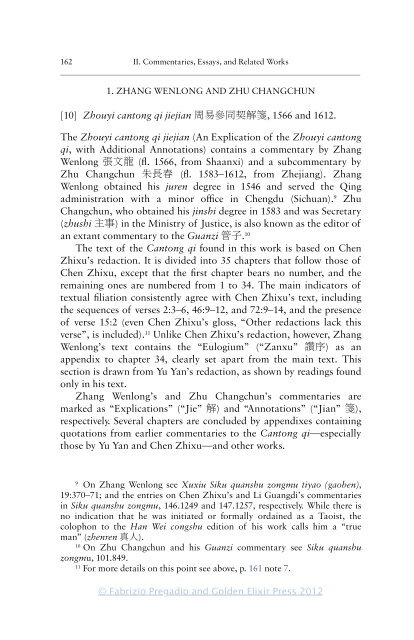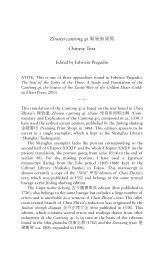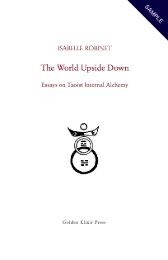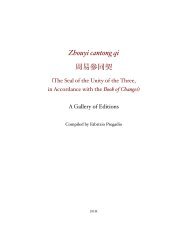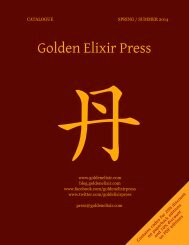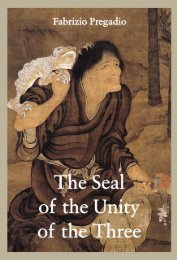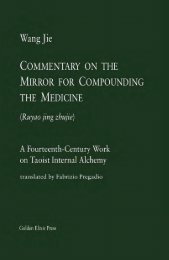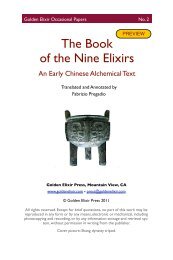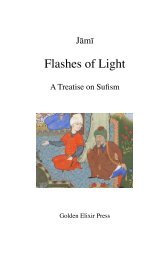The Seal of the Unity of the Three â Vol. 2 - The Golden Elixir
The Seal of the Unity of the Three â Vol. 2 - The Golden Elixir
The Seal of the Unity of the Three â Vol. 2 - The Golden Elixir
- No tags were found...
Create successful ePaper yourself
Turn your PDF publications into a flip-book with our unique Google optimized e-Paper software.
162 II. Commentaries, Essays, and Related Works<br />
—————————————————————————————————————————<br />
1. ZHANG WENLONG AND ZHU CHANGCHUN<br />
[10] Zhouyi cantong qi jiejian 周 易 參 同 契 解 箋 , 1566 and 1612.<br />
<strong>The</strong> Zhouyi cantong qi jiejian (An Explication <strong>of</strong> <strong>the</strong> Zhouyi cantong<br />
qi, with Additional Annotations) contains a commentary by Zhang<br />
Wenlong 張 文 龍 (fl. 1566, from Shaanxi) and a subcommentary by<br />
Zhu Changchun 朱 長 春 (fl. 1583–1612, from Zhejiang). Zhang<br />
Wenlong obtained his juren degree in 1546 and served <strong>the</strong> Qing<br />
administration with a minor <strong>of</strong>fice in Chengdu (Sichuan). 9 Zhu<br />
Changchun, who obtained his jinshi degree in 1583 and was Secretary<br />
(zhushi 主 事 ) in <strong>the</strong> Ministry <strong>of</strong> Justice, is also known as <strong>the</strong> editor <strong>of</strong><br />
an extant commentary to <strong>the</strong> Guanzi 管 子 . 10<br />
<strong>The</strong> text <strong>of</strong> <strong>the</strong> Cantong qi found in this work is based on Chen<br />
Zhixu’s redaction. It is divided into 35 chapters that follow those <strong>of</strong><br />
Chen Zhixu, except that <strong>the</strong> first chapter bears no number, and <strong>the</strong><br />
remaining ones are numbered from 1 to 34. <strong>The</strong> main indicators <strong>of</strong><br />
textual filiation consistently agree with Chen Zhixu’s text, including<br />
<strong>the</strong> sequences <strong>of</strong> verses 2:3–6, 46:9–12, and 72:9–14, and <strong>the</strong> presence<br />
<strong>of</strong> verse 15:2 (even Chen Zhixu’s gloss, “O<strong>the</strong>r redactions lack this<br />
verse”, is included). 11 Unlike Chen Zhixu’s redaction, however, Zhang<br />
Wenlong’s text contains <strong>the</strong> “Eulogium” (“Zanxu” 讚 序 ) as an<br />
appendix to chapter 34, clearly set apart from <strong>the</strong> main text. This<br />
section is drawn from Yu Yan’s redaction, as shown by readings found<br />
only in his text.<br />
Zhang Wenlong’s and Zhu Changchun’s commentaries are<br />
marked as “Explications” (“Jie” 解 ) and “Annotations” (“Jian” 箋 ),<br />
respectively. Several chapters are concluded by appendixes containing<br />
quotations from earlier commentaries to <strong>the</strong> Cantong qi—especially<br />
those by Yu Yan and Chen Zhixu—and o<strong>the</strong>r works.<br />
9<br />
On Zhang Wenlong see Xuxiu Siku quanshu zongmu tiyao (gaoben),<br />
19:370–71; and <strong>the</strong> entries on Chen Zhixu’s and Li Guangdi’s commentaries<br />
in Siku quanshu zongmu, 146.1249 and 147.1257, respectively. While <strong>the</strong>re is<br />
no indication that he was initiated or formally ordained as a Taoist, <strong>the</strong><br />
colophon to <strong>the</strong> Han Wei congshu edition <strong>of</strong> his work calls him a “true<br />
man” (zhenren 真 人 ).<br />
10<br />
On Zhu Changchun and his Guanzi commentary see Siku quanshu<br />
zongmu, 101.849.<br />
11<br />
For more details on this point see above, p. 161 note 7.<br />
© Fabrizio Pregadio and <strong>Golden</strong> <strong>Elixir</strong> Press 2012


